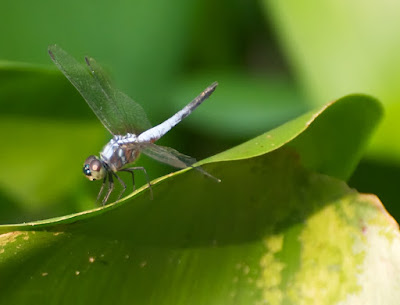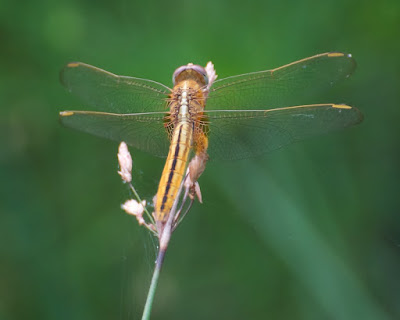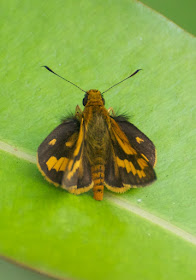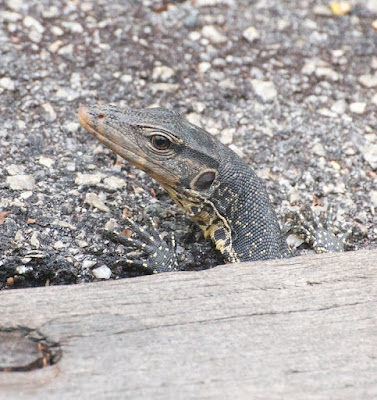The garden is very large, and it occupied us for most of the day. Besides the well-laid-out paths and interesting plantings, it has an extensive series of ponds - which means, for a pair of strolling naturalists, that it attracts a fair assortment of aquatic animal life as well.
One of the more attractive ponds in the garden features the Giant Amazon Water Lily (Victoria amazonica), a native (as its name implies) of tropical South America.
Victoria amazonica is the world's largest water lily (the Water Monitor (Varanus salvator) swimming past in the lower picture provides some scale). It has a remarkable life history to boot. The flowers last two days. They are white and female the first day, and emit chemicals that attract pollinating beetles. By the second day they are deep pink, odorless and male.
Fishes in the ponds included this Common Snakehead (Channa striata), a widespread species much prized as a food fish (which may be fair play, as it is a pretty voracious predator itself.
The ponds were dotted with water striders skimming over the surface, joined occasionally (as here) by visiting damselflies (Pseudagrion microcephalum).
It's abundance of standing water makes the garden a good place to find an assortment of Singapore's urban Odonata. Pseudagrion microcephalum is the commonest of the local damselflies.
The dragonflies we found were almost all common species, although I did see (but could not photograph properly) one new species, Orchithemis pruinosum, which was easy to identify (it is mostly black, with a wide white girdle around the base of the abdomen) but frustratingly difficult to approach. I had to settle, instead, for more familiar insects, including Orthetrum chrysis...
...and it's nearly ubiquitous cousin, Orthetrum sabina.
Other common dragonflies in the garden included Rhodothemis rufa, the Common Redbolt.
I was surprised by how often I saw Trithemis aurora, a dragonfly I usually associate more with rocky streams. I photographed both the black-and-yellow female...
Brachydiplax chalybea was common here, as it seems to be almost everywhere there is standing water and emergent vegetation.
The female of Crocothemis servilia may be no match in colour for the brilliant scarlet male, but the sharp dark stripe down the upper surface of the abdomen at least makes her easy to identify.
One of Southeast Asia's surprises for a visiting birder from North America is how hard it is to come by a duck. If you do, it is likely to be this one: the Lesser Whistling-duck (Dendrocygna javanica). Usually they are wary and hard to approach, but the birds on the garden lakes were remarkably tame. The reason is that they are probably not really part of Singapore's dwindling population of indigenous Lesser Whistling-Ducks, but deliberate introductions. Some of them, indeed, may not even be purebred Lesser Whistling-Ducks but hybrids with another species, the Wandering Whistling-Duck (D. arcuata); a hybrid family has been seen in the gardens since 2012. These birds, though, seem to be true Lessers, lacking the darker crown and plumed flanks of the Wandering.
The White-breasted Waterhen (Amaurornis phoenicurus)can turn up even in a city-centre roadside ditch or wandering around someone's lawn, so it was no surprise to find one on the lakeside.
Of course the chief reason to have a botanical garden at all is to display, and teach people about, plants. I thought the displays were very well done, with a real eye to education. I particularly appreciated the Evolution Garden, a nod to plant prehistory (organized by timeline) featuring ferns, horsetails, conifers and cycads (and some reconstructions in concrete of plants that no longer exist, such as the coal-age tree Lepidodendron) - lineages that dominated the world before the explosion of flowering plants in the Cretaceous, and therefore as close as we can get to a true Jurassic Park.
Cycads have always impressed me, both for their geological age and their considerable beauty (unfortunately the same features have made wild populations the target of plant poachers).
One of the advantages of plant-watching in a botanical garden is – or to be – that most of the plants are labeled, so there is no excuse for not knowing the name of any plant you happen to admire. Unfortunately, I was so struck by the unusual flowers on this tree that I completely forgot to take down the label information, so I have no idea what this is despite diligent attempts to find it illustrated somewhere.
Where there are plants, of course, there are plant-eating insects.
Here is one of them, a leafhopper (Bothrogonia sp., probably B. ferruginea).
And where there are plant-eating insects, there are spiders to prey on them.
This Chocolate Pansy (Junonia hedonia ida) appears to have had a narrow escape, probably from a bird or a lizard drawn to the eyespots on its hindwing.
This male Green Baron (Euthalia adonia), a common butterfly in Singapore but one that was new to me, lacks the female's broad white bar across the wings.
The Lesser Dart (Potanthus omaha omaha) is a common skipper in Singspore (regular readers will have already met it in the last entry, about our trip to Sungei Buloh).
From an ecological point of view, the most important thing about the Singapore Botanic Gardens may be that it preserves a 6-hectare remnant of the island's original dipterocarp rainforest. Though that is far too small an area to support such things as specialized rainforest birds, it does protect some rare and magnificent trees.
There are animals here too, including this frog (which I have not been able to identify).
The trail through the rainforest turned up both of Singapore's common squirrels. This is the ubiquitous Plantain Squirrel (Callosciurus notatus).
This is the smaller, and plainer, Slender Squirrel (Sundasciurus tenuis).
This Common Treeshrew (Tupaia glis) had found a particularly tasty large fruit on the forest floor. Its presence in this little patch of forest was a surprise to me; it is otherwise pretty much confined to the more extensive forest tracts in the Central Catchment Area and the Bukit Timah Nature Reserve.
Ryan is posing with a most interesting animal. Water Monitors (Varanus salvator) are widespread and frequently seen in both Malaysia and Singapore, but this was the first time I had come across one of its smaller cousins.
The Clouded Monitor (Varanus nebulosus) is a forest lizard, less tied to water than the Water Monitor. It's near relative in India, the Bengal Monitor (V. bengalensis), even lives in semidesert conditions in part of its range. Though it is widespread in Southeast Asia, from Myanmar to Java, it does not occur in Borneo – which may explain why I had never seen one.
Elsewhere in the gardens, Water Monitors (Varanus salvator) were the common species.
Most of the ones we saw were large adults, but this youngster crawled out from under one of the boardwalks to bask in the sun. Young Water Monitors are much more strongly patterned then they will be as adults, so there is little risk of confusing them with the more subtly-marked Clouded Monitor.
The water monitors did not have the ponds entirely to themselves. This is a Malayan Giant Terrapin (Orlitia borneensis), an increasingly rare species in Southeast Asia. Like the Whistling-Ducks, the terrapins in Singapore have probably been introduced. Nonetheless, this impressive turtle is another bit of evidence that the Singapore Botanic Garden contributes something special to the urban life of the island.
...and the day-glo pink male. This is a dragonfly that often takes up the obelisk position, with its abdomen rises so high that it seems that the insect is about to topple over (upper photo).
Brachydiplax chalybea was common here, as it seems to be almost everywhere there is standing water and emergent vegetation.
The female of Crocothemis servilia may be no match in colour for the brilliant scarlet male, but the sharp dark stripe down the upper surface of the abdomen at least makes her easy to identify.
One of Southeast Asia's surprises for a visiting birder from North America is how hard it is to come by a duck. If you do, it is likely to be this one: the Lesser Whistling-duck (Dendrocygna javanica). Usually they are wary and hard to approach, but the birds on the garden lakes were remarkably tame. The reason is that they are probably not really part of Singapore's dwindling population of indigenous Lesser Whistling-Ducks, but deliberate introductions. Some of them, indeed, may not even be purebred Lesser Whistling-Ducks but hybrids with another species, the Wandering Whistling-Duck (D. arcuata); a hybrid family has been seen in the gardens since 2012. These birds, though, seem to be true Lessers, lacking the darker crown and plumed flanks of the Wandering.
The White-breasted Waterhen (Amaurornis phoenicurus)can turn up even in a city-centre roadside ditch or wandering around someone's lawn, so it was no surprise to find one on the lakeside.
Of course the chief reason to have a botanical garden at all is to display, and teach people about, plants. I thought the displays were very well done, with a real eye to education. I particularly appreciated the Evolution Garden, a nod to plant prehistory (organized by timeline) featuring ferns, horsetails, conifers and cycads (and some reconstructions in concrete of plants that no longer exist, such as the coal-age tree Lepidodendron) - lineages that dominated the world before the explosion of flowering plants in the Cretaceous, and therefore as close as we can get to a true Jurassic Park.
Cycads have always impressed me, both for their geological age and their considerable beauty (unfortunately the same features have made wild populations the target of plant poachers).
One of the advantages of plant-watching in a botanical garden is – or to be – that most of the plants are labeled, so there is no excuse for not knowing the name of any plant you happen to admire. Unfortunately, I was so struck by the unusual flowers on this tree that I completely forgot to take down the label information, so I have no idea what this is despite diligent attempts to find it illustrated somewhere.
Where there are plants, of course, there are plant-eating insects.
Here is one of them, a leafhopper (Bothrogonia sp., probably B. ferruginea).
And where there are plant-eating insects, there are spiders to prey on them.
This Chocolate Pansy (Junonia hedonia ida) appears to have had a narrow escape, probably from a bird or a lizard drawn to the eyespots on its hindwing.
Butterflies, as you might expect, were abundant in the garden. Here, a Common Palmfly (Elymnias hypermnestra) investigates a flowering ginger.
The Lesser Dart (Potanthus omaha omaha) is a common skipper in Singspore (regular readers will have already met it in the last entry, about our trip to Sungei Buloh).
From an ecological point of view, the most important thing about the Singapore Botanic Gardens may be that it preserves a 6-hectare remnant of the island's original dipterocarp rainforest. Though that is far too small an area to support such things as specialized rainforest birds, it does protect some rare and magnificent trees.
There are animals here too, including this frog (which I have not been able to identify).
The trail through the rainforest turned up both of Singapore's common squirrels. This is the ubiquitous Plantain Squirrel (Callosciurus notatus).
This is the smaller, and plainer, Slender Squirrel (Sundasciurus tenuis).
This Common Treeshrew (Tupaia glis) had found a particularly tasty large fruit on the forest floor. Its presence in this little patch of forest was a surprise to me; it is otherwise pretty much confined to the more extensive forest tracts in the Central Catchment Area and the Bukit Timah Nature Reserve.
Ryan is posing with a most interesting animal. Water Monitors (Varanus salvator) are widespread and frequently seen in both Malaysia and Singapore, but this was the first time I had come across one of its smaller cousins.
The Clouded Monitor (Varanus nebulosus) is a forest lizard, less tied to water than the Water Monitor. It's near relative in India, the Bengal Monitor (V. bengalensis), even lives in semidesert conditions in part of its range. Though it is widespread in Southeast Asia, from Myanmar to Java, it does not occur in Borneo – which may explain why I had never seen one.
Elsewhere in the gardens, Water Monitors (Varanus salvator) were the common species.
Most of the ones we saw were large adults, but this youngster crawled out from under one of the boardwalks to bask in the sun. Young Water Monitors are much more strongly patterned then they will be as adults, so there is little risk of confusing them with the more subtly-marked Clouded Monitor.
The water monitors did not have the ponds entirely to themselves. This is a Malayan Giant Terrapin (Orlitia borneensis), an increasingly rare species in Southeast Asia. Like the Whistling-Ducks, the terrapins in Singapore have probably been introduced. Nonetheless, this impressive turtle is another bit of evidence that the Singapore Botanic Garden contributes something special to the urban life of the island.





















































No comments:
Post a Comment